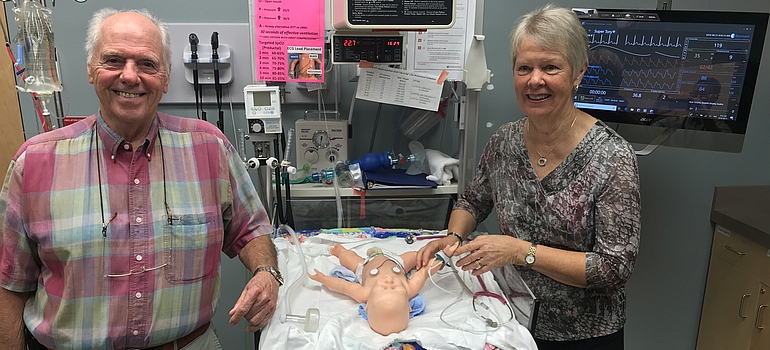
Colin and Lois Pritchard with SuperTory, the new neonatal patient simulator in the Pritchard Simulation Centre.
One of the world’s most advanced neonatal patient simulators has found a home at the Pritchard Simulation Centre at Kelowna General Hospital (KGH). SuperTory is a high-fidelity mannequin that fully simulates the breathing, movement, skin colouration, and vital signs of a newborn baby.
SuperTory is the first simulator to replicate all stages of respiratory management including diagnosis, treatment, weaning, and rehabilitation of a newborn patient. It can be easily programmed to reproduce low to high-risk scenarios providing a realistic, risk-free training environment for healthcare professionals and learners.
“With its ability to breath, blink, and respond to medical interventions, the simulator is incredibly lifelike,” says JoAnne Slinn, Regional Knowledge Coordinator for Interior Health at KGH. “We can connect SuperTory to real monitors and a ventilator to enhance the realism of the training experience.”
Interior Health staff, Southern Medical Program students, and UBC residents training at KGH will benefit from interdisciplinary sessions at the Clinical Academic Campus and in situ simulation where the training takes place within the clinical environment in the hospital. Additionally, Interior Health can easily transport SuperTory to support urgent care simulation training throughout the region.
“The simulator gives us the ability to train and improve the care of our most vulnerable patient population,” Slinn adds. “It will help advance pediatric patient care and training in BC Interior hospitals.”
The donation of SuperTory to UBC and Interior Health was made possible through a gift from The Colin & Lois Pritchard Foundation. The Pritchards have been tremendous supporters of medical education and training in the region.
“We were amazed by the realism of SuperTory”, says Colin Pritchard following a demonstration of the infant simulator. “Lois and I are very pleased to be able to help UBC give its students and health care professionals the very best training environment possible so they can deliver the best health care possible to patients.”